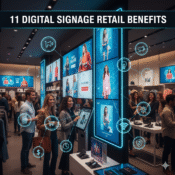
Guide to Buying Digital Signage Software (2025 Edition)
Digital signage has transformed how businesses communicate, advertise, and engage with their audiences. At the heart of this transformation lies digital signage software—the backbone of modern digital display systems. From scheduling and content management to audience analytics, the right software ensures your screens deliver maximum impact.
But with the digital signage market expanding rapidly in 2025, choosing the right software has become more complex than ever. Businesses face a wide variety of options, pricing models, and features that can either enhance communication or create unnecessary challenges.
This guide provides a comprehensive roadmap for selecting the best digital signage software in 2025, covering critical features, pricing considerations, industry-specific needs, and future trends.
Understanding Digital Signage Software
What Is Digital Signage Software?
Digital signage software is a platform that allows businesses to design, manage, and distribute digital content across screens, kiosks, and interactive displays. It acts as the control center, ensuring messages reach the right audience at the right time.
Types of Digital Signage Software
- Cloud-Based Solutions – Hosted online, accessible from anywhere, ideal for multi-location businesses.
- On-Premise Solutions – Installed locally, offering full control but requiring higher maintenance.
- Hybrid Models – Combine the flexibility of cloud with local reliability for sensitive data.
Key Functions of Digital Signage Software
- Content creation and editing
- Playlist scheduling and automated triggers
- Device monitoring and control
- Data analytics and audience measurement
Industry Applications
- Retail: In-store promotions, dynamic product displays
- Corporate: Internal communications, dashboards
- Healthcare: Patient information, wayfinding
- Education: Digital notice boards, interactive learning
- Hospitality: Event boards, guest information systems
Critical Features to Look for in Digital Signage Software
1. User-Friendly Interface and Ease of Use
- Drag-and-drop content editors for quick design
- Pre-built templates and customizable layouts
- Multi-user access with role-based permissions for teams
2. Content Management and Scheduling
- Real-time updates for time-sensitive campaigns
- Flexible scheduling (dayparting, rule-based triggers)
- Support for images, video, HTML5, and live feeds
- Multi-location and multi-screen distribution
3. Compatibility and Integration
- Hardware support: Android, Windows, Linux, Chrome OS players
- Third-party integrations: social media, POS systems, CRM, ERP
- API availability for custom business workflows
4. Scalability and Flexibility
- Suitable for startups, SMEs, and global enterprises
- Cloud scalability for growing screen networks
- Multi-language and audience-specific content delivery
5. Pricing Models and Total Cost of Ownership
- Subscription-based: Monthly/annual recurring costs
- One-time licenses: Higher upfront cost, long-term savings
- Usage-based pricing: Pay per screen, user, or feature set
- Hidden costs to consider: onboarding, updates, support, and hardware
6. Security and Compliance
- Encrypted data transmission and secure content delivery
- Compliance with GDPR, HIPAA, and industry-specific regulations
- Role-based user authentication and content access control
7. Analytics and Reporting
- Audience engagement measurement
- Proof of Play reports for advertisers
- Data-driven insights for content optimization
8. Support and Training
- Multi-channel support: phone, email, live chat
- Training resources: webinars, tutorials, and onboarding sessions
- Community forums and documentation for peer support
Comparing Top Digital Signage Software for 2025
The digital signage software landscape in 2025 includes both long-standing leaders and innovative newcomers. Below are some top contenders:
- AIScreen – Cloud-first platform, excellent for enterprise scalability
- ScreenCloud – User-friendly, ideal for SMEs and multi-location businesses
- NoviSign – Strong focus on education and healthcare solutions
- Mandoe – Great for small businesses with intuitive design tools
Each platform varies in pricing, integrations, and target industries. Businesses should carefully match their organizational goals with the platform’s strengths before making a choice.
Aligning Software Choice with Business Goals
The best digital signage software is the one that aligns seamlessly with your company’s communication strategy.
- Branding and Marketing: Retailers may need high-impact visuals and real-time promotions.
- Internal Communication: Corporations might prioritize integrations with dashboards and collaboration tools.
- Training and Education: Schools and enterprises may require interactive, multi-device features.
Example Case Study
A healthcare network implemented cloud-based signage integrated with their patient management system. The result: a 30% reduction in missed appointments and improved patient satisfaction through real-time updates.
Common Pitfalls and How to Avoid Them
- Overlooking Scalability – Choose software that can grow with your needs.
- Ignoring Integrations – Verify compatibility with existing systems.
- Underestimating Costs – Account for long-term licensing and support fees.
- Neglecting Usability Testing – Always test usability before full deployment.
Steps to Make an Informed Purchase Decision
- Gather Requirements – Define business goals and involve stakeholders.
- Request Demos – Shortlist providers and run pilot programs.
- Evaluate Vendors – Compare features, reliability, and service quality.
- Negotiate Contracts – Review terms, SLAs, and pricing structures.
Future Trends in Digital Signage Software (2025 and Beyond)
- AI-Driven Content Automation – Personalized content based on demographics and behavior.
- Enhanced Analytics – Machine learning for predictive engagement insights.
- Edge Computing – Faster processing with hybrid cloud-local models.
- Interactive Experiences – Touchscreens, QR-based engagement, and mobile integration.
Conclusion
Choosing the right digital signage software in 2025 is a strategic decision that impacts customer engagement, brand visibility, and operational efficiency. Businesses must evaluate usability, scalability, integrations, and cost-effectiveness before committing to a platform.
The key takeaway: select software that not only meets your current needs but also adapts to your future growth and evolving technologies.
FAQs
1. What are the key differences between cloud-based and on-premise digital signage software?
Cloud-based solutions offer flexibility and remote management, while on-premise solutions provide more control but require higher maintenance. Hybrid options combine both.
2. How important is software scalability for growing businesses?
Scalability is critical. As businesses expand their screen networks, scalable software ensures seamless management without the need for costly migrations.
3. Can digital signage software integrate with existing business systems?
Yes, leading platforms integrate with POS, CRM, ERP, and social media systems, allowing seamless workflows and content automation.
4. What pricing models are most common in digital signage software in 2025?
Most vendors offer subscription-based pricing, while some provide one-time licenses or usage-based models depending on the number of screens or features.



